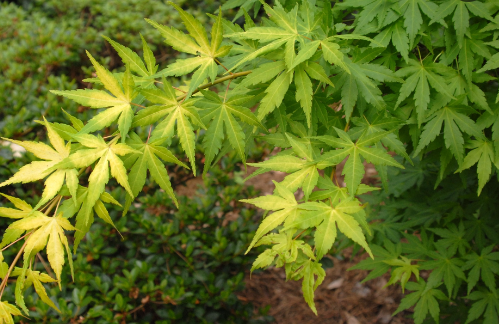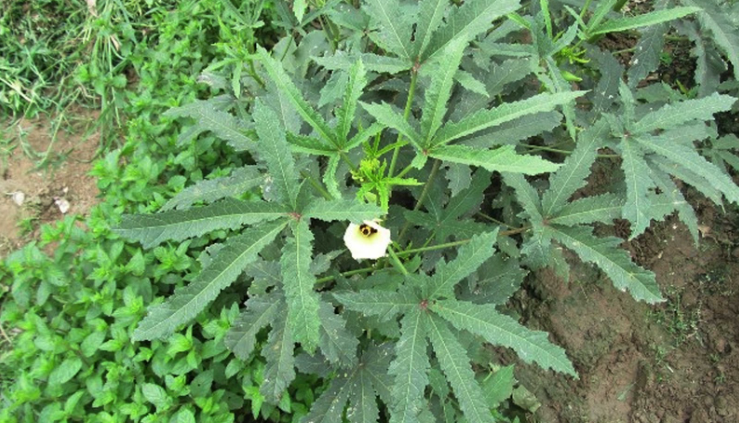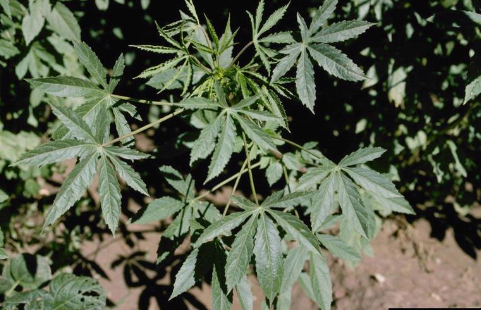There exist plants in nature that bear an uncanny resemblance to one of the most controversial botanical species: marijuana (Cannabis sativa). While marijuana itself has garnered widespread attention for its psychoactive properties and medicinal potential, its look-alikes dwell quietly in the natural world, often unnoticed or misconstrued.
What Does Marijuana Look Like?
Cannabis sativa plants have long, slender stems with large palm-shaped leaves that are attached to the stem at nodes. These fan-like leaves have a serrated edge that is often likened to a maple leaf.
The cannabis leaf is composed of smaller leaflets that converge at the petiole or leaf stalk. Leaves exhibit a darker green hue on the upper surface and a lighter shade underneath, with a covering of fine hairs on both sides.
In addition to leaf characteristics, the bud structure of female cannabis plants serves as another identifying feature. Cannabis sativa yields dense buds shielded by minute leaves referred to as sugar leaves. As these buds approach maturity, the elongated pistils at their core gradually transition to a deep burnt orange hue, typically occurring during the seventh and eighth weeks of the flowering stage.
Fully developed buds present a crystalline appearance, as if coated with translucent crystals formed by resinous glandular trichomes. Clusters of cannabis buds often form tightly-packed formations known as colas.
Here is a list of plants that look like Marijuana:
- Japanese Maple (Acer palmatum)
- Southern Marigold (Tagetes minuta)
- Sunn Hemp (Crotalaria juncea)
- Coral Plant (Jatropha multifida)
- Okra (Abelmoschus esculentus)
- Cassava (Manihot esculenta)
- Spider Flower (Cleome hassleriana)
- Texas Star Hibiscus (Hibiscus coccineus)
- Chaste Tree (Vitex agnus-castus)
Japanese Maple (Acer palmatum)

The Japanese maple, a renowned ornamental tree originating from Asia, is often mistaken for the marijuana plant, particularly during its early stages of growth. At this phase, the tree displays a slender and flexible stem adorned with bright green leaves resembling the compound palmate leaf of Cannabis sativa, featuring a toothed or serrated margin.
However, the resemblance between the Japanese maple and cannabis plant ceases there. As late spring and summer arrive, leaves of Acer palmatum typically undergo a transformation, showcasing hues of red, pink, and purple. With the progression of the first growing season, the stem matures into a woody structure, thickening into a tree trunk. Notably, Japanese maple leaves lack fine hairs (glabrous), unlike cannabis leaves which are covered in them.
Southern Marigold (Tagetes minuta)

The Southern marigold, also referred to as Muster-John-Henry, originates from Central America and serves culinary and medicinal purposes. However, due to its rapid spread, the shrub is often categorized as a weed, thriving quickly in cultivated or disturbed land, including areas near crops, vegetables, pastures, orchards, and abandoned lots.
In its seedling stage, the marigold bears a striking resemblance to the marijuana plant. Tagetes minuta features long, slender leaves with finely serrated edges, similar in appearance to cannabis. Moreover, both plants can attain a comparable size.
Despite their visual similarities, there exist distinct features to differentiate marigolds from marijuana. Marigolds produce petite yellow flowers, whereas marijuana yields green and purple buds. Additionally, marigold leaves do not form a compound structure composed of leaflets; instead, each leaf attaches individually to the stem.
Sunn Hemp (Crotalaria juncea)

Sunn hemp and Cannabis sativa are often mistaken for one another due to their similar appearance. Originating from India, sunn hemp is widespread in tropical and subtropical regions worldwide, commonly utilized today as a green manure crop.
Both industrial hemp and sunn hemp plants exhibit resemblances, featuring elongated, slender green leaves with serrated edges. Comparable to Cannabis sativa, sunn hemp can reach heights of two meters or more, boasting a slender stalk.
Fortunately, distinguishing between the two plants is straightforward. Sunn hemp distinguishes itself with bright yellow flowers, contrasting with the green or purple-tinged buds of cannabis. A closer examination reveals that sunn hemp leaves are singular (not compound) and elliptical in shape, setting them apart from the leaves of cannabis.
Coral Plant (Jatropha multifida)

The coral plant, also known as coralbush, originates from Mexico and the Caribbean and bears a striking resemblance to cannabis. Much like marijuana, the coral plant’s palm-shaped leaves consist of leaflets emerging from a single point, typically comprising seven to eleven lobes, which can be mistaken for cannabis (which possesses up to eleven leaflets).
However, upon closer examination, distinct differences between coralbush and weed become apparent. Unlike cannabis, the leaves of the coral plant are lobed rather than divided into separate leaflets. Additionally, while Cannabis sativa produces buds in subdued green and purple tones, the coral plant showcases clusters of vibrant pink flowers.
Moreover, the coralbush is characterized by its unpleasant odor, often likened to cat urine, a feature absent in cannabis. Lastly, when damaged, the plant emits a thick white substance, a trait not observed in cannabis.
Okra (Abelmoschus esculentus)

Okra, renowned worldwide for its edible green pods and extensive use in traditional medicine, originates from tropical regions of Asia and Africa but is now widespread in gardens across tropical and subtropical regions globally.
The confusion between okra and Cannabis sativa often arises due to their similar leaf structures, both featuring broad green, palmate-style leaves and reaching considerable heights, making them indistinguishable from a distance.
These resemblances have resulted in noteworthy incidents, such as the Georgia State Patrol mistaking an okra plantation for a cannabis farm during a helicopter surveillance operation. Upon closer inspection, it was revealed to be okra, prompting an apology from the State Patrol Captain. A more thorough examination would have prevented the misunderstanding, as they would have recognized it as a culinary ingredient rather than an illicit substance.
Okra is characterized by its large white or yellow flowers, in contrast to the small green or purple buds and flowers of cannabis. Furthermore, while cannabis plants possess up to eleven leaflets, okra plants have a maximum of seven lobes. Additionally, mature okra plants produce distinctive large green pods, aiding in their differentiation from cannabis.
Kenaf (Hibiscus cannabinus)

Kenaf bears such a striking resemblance to cannabis that its botanical name, Hibiscus cannabinus, directly references it. Originating from Southern Asia and Africa, kenaf is primarily grown for its fiber. During its early growth stages, kenaf closely resembles cannabis, with both plants featuring palmate-style leaves sporting serrated edges.
Distinguishing between these plants becomes easier as they mature. Hibiscus cannabinus produces vibrant yellow or scarlet flowers complete with sepals, petals, stamens, and carpels, while cannabis yields subtler, more subdued buds. Unlike cannabis, kenaf leaves are lobed rather than divided into separate leaflets. Lower leaves on the kenaf plant exhibit a heart-shaped appearance, while those higher up resemble a palm or star. Conversely, marijuana leaves maintain a consistent shape regardless of their position on the plant.
Chaste Tree (Vitex agnus-castus)

Belonging to the Verbenaceae family, which counts lemon verbena among its members, the Chaste tree, also known as monk’s pepper, flourishes in rocky Mediterranean climates. According to legend, monks purportedly administered it to individuals with excessive libido as an anaphrodisiac, hence the plant’s moniker.
Due to the resemblance of its young leaves to marijuana leaves, the Chaste tree is frequently mistaken for cannabis. Its leaves are arranged palmately, comprising five leaflets.
Nevertheless, a discerning observer can readily differentiate between these two species. Unlike the serrated margins of cannabis leaves, those of the Chaste tree are smooth, with a slight curling under at the ends. Additionally, the Chaste tree bears large clusters of light purple flowers and berries, a stark contrast to the marijuana plant’s subtler and less conspicuous buds.